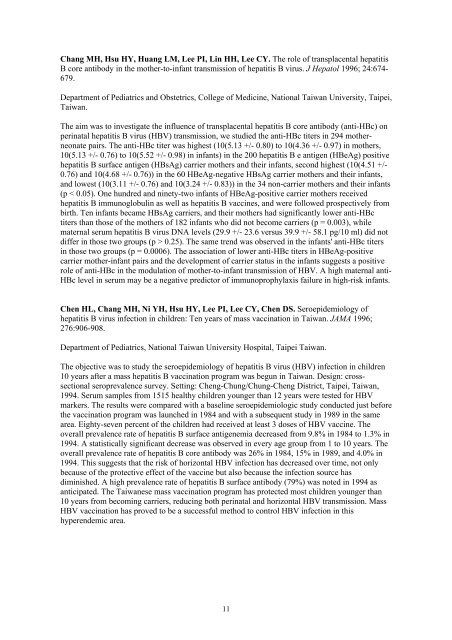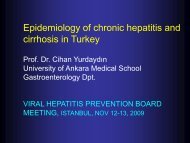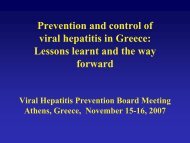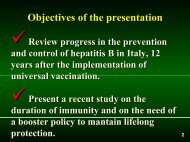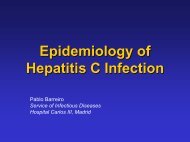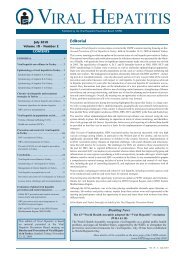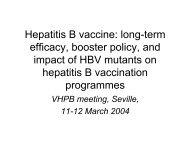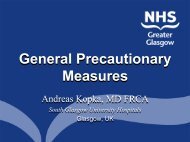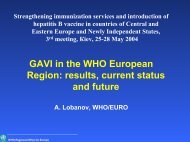Prevention and control of perinatal hepatitis B virus transmission in ...
Prevention and control of perinatal hepatitis B virus transmission in ...
Prevention and control of perinatal hepatitis B virus transmission in ...
You also want an ePaper? Increase the reach of your titles
YUMPU automatically turns print PDFs into web optimized ePapers that Google loves.
Chang MH, Hsu HY, Huang LM, Lee PI, L<strong>in</strong> HH, Lee CY. The role <strong>of</strong> transplacental <strong>hepatitis</strong>B core antibody <strong>in</strong> the mother-to-<strong>in</strong>fant <strong>transmission</strong> <strong>of</strong> <strong>hepatitis</strong> B <strong>virus</strong>. J Hepatol 1996; 24:674-679.Department <strong>of</strong> Pediatrics <strong>and</strong> Obstetrics, College <strong>of</strong> Medic<strong>in</strong>e, National Taiwan University, Taipei,Taiwan.The aim was to <strong>in</strong>vestigate the <strong>in</strong>fluence <strong>of</strong> transplacental <strong>hepatitis</strong> B core antibody (anti-HBc) on<strong>per<strong>in</strong>atal</strong> <strong>hepatitis</strong> B <strong>virus</strong> (HBV) <strong>transmission</strong>, we studied the anti-HBc titers <strong>in</strong> 294 motherneonatepairs. The anti-HBc titer was highest (10(5.13 +/- 0.80) to 10(4.36 +/- 0.97) <strong>in</strong> mothers,10(5.13 +/- 0.76) to 10(5.52 +/- 0.98) <strong>in</strong> <strong>in</strong>fants) <strong>in</strong> the 200 <strong>hepatitis</strong> B e antigen (HBeAg) positive<strong>hepatitis</strong> B surface antigen (HBsAg) carrier mothers <strong>and</strong> their <strong>in</strong>fants, second highest (10(4.51 +/-0.76) <strong>and</strong> 10(4.68 +/- 0.76)) <strong>in</strong> the 60 HBeAg-negative HBsAg carrier mothers <strong>and</strong> their <strong>in</strong>fants,<strong>and</strong> lowest (10(3.11 +/- 0.76) <strong>and</strong> 10(3.24 +/- 0.83)) <strong>in</strong> the 34 non-carrier mothers <strong>and</strong> their <strong>in</strong>fants(p < 0.05). One hundred <strong>and</strong> n<strong>in</strong>ety-two <strong>in</strong>fants <strong>of</strong> HBeAg-positive carrier mothers received<strong>hepatitis</strong> B immunoglobul<strong>in</strong> as well as <strong>hepatitis</strong> B vacc<strong>in</strong>es, <strong>and</strong> were followed prospectively frombirth. Ten <strong>in</strong>fants became HBsAg carriers, <strong>and</strong> their mothers had significantly lower anti-HBctiters than those <strong>of</strong> the mothers <strong>of</strong> 182 <strong>in</strong>fants who did not become carriers (p = 0.003), whilematernal serum <strong>hepatitis</strong> B <strong>virus</strong> DNA levels (29.9 +/- 23.6 versus 39.9 +/- 58.1 pg/10 ml) did notdiffer <strong>in</strong> those two groups (p > 0.25). The same trend was observed <strong>in</strong> the <strong>in</strong>fants' anti-HBc titers<strong>in</strong> those two groups (p = 0.0006). The association <strong>of</strong> lower anti-HBc titers <strong>in</strong> HBeAg-positivecarrier mother-<strong>in</strong>fant pairs <strong>and</strong> the development <strong>of</strong> carrier status <strong>in</strong> the <strong>in</strong>fants suggests a positiverole <strong>of</strong> anti-HBc <strong>in</strong> the modulation <strong>of</strong> mother-to-<strong>in</strong>fant <strong>transmission</strong> <strong>of</strong> HBV. A high maternal anti-HBc level <strong>in</strong> serum may be a negative predictor <strong>of</strong> immunoprophylaxis failure <strong>in</strong> high-risk <strong>in</strong>fants.Chen HL, Chang MH, Ni YH, Hsu HY, Lee PI, Lee CY, Chen DS. Seroepidemiology <strong>of</strong><strong>hepatitis</strong> B <strong>virus</strong> <strong>in</strong>fection <strong>in</strong> children: Ten years <strong>of</strong> mass vacc<strong>in</strong>ation <strong>in</strong> Taiwan. JAMA 1996;276:906-908.Department <strong>of</strong> Pediatrics, National Taiwan University Hospital, Taipei Taiwan.The objective was to study the seroepidemiology <strong>of</strong> <strong>hepatitis</strong> B <strong>virus</strong> (HBV) <strong>in</strong>fection <strong>in</strong> children10 years after a mass <strong>hepatitis</strong> B vacc<strong>in</strong>ation program was begun <strong>in</strong> Taiwan. Design: crosssectionalseroprevalence survey. Sett<strong>in</strong>g: Cheng-Chung/Chung-Cheng District, Taipei, Taiwan,1994. Serum samples from 1515 healthy children younger than 12 years were tested for HBVmarkers. The results were compared with a basel<strong>in</strong>e seroepidemiologic study conducted just beforethe vacc<strong>in</strong>ation program was launched <strong>in</strong> 1984 <strong>and</strong> with a subsequent study <strong>in</strong> 1989 <strong>in</strong> the samearea. Eighty-seven percent <strong>of</strong> the children had received at least 3 doses <strong>of</strong> HBV vacc<strong>in</strong>e. Theoverall prevalence rate <strong>of</strong> <strong>hepatitis</strong> B surface antigenemia decreased from 9.8% <strong>in</strong> 1984 to 1.3% <strong>in</strong>1994. A statistically significant decrease was observed <strong>in</strong> every age group from 1 to 10 years. Theoverall prevalence rate <strong>of</strong> <strong>hepatitis</strong> B core antibody was 26% <strong>in</strong> 1984, 15% <strong>in</strong> 1989, <strong>and</strong> 4.0% <strong>in</strong>1994. This suggests that the risk <strong>of</strong> horizontal HBV <strong>in</strong>fection has decreased over time, not onlybecause <strong>of</strong> the protective effect <strong>of</strong> the vacc<strong>in</strong>e but also because the <strong>in</strong>fection source hasdim<strong>in</strong>ished. A high prevalence rate <strong>of</strong> <strong>hepatitis</strong> B surface antibody (79%) was noted <strong>in</strong> 1994 asanticipated. The Taiwanese mass vacc<strong>in</strong>ation program has protected most children younger than10 years from becom<strong>in</strong>g carriers, reduc<strong>in</strong>g both <strong>per<strong>in</strong>atal</strong> <strong>and</strong> horizontal HBV <strong>transmission</strong>. MassHBV vacc<strong>in</strong>ation has proved to be a successful method to <strong>control</strong> HBV <strong>in</strong>fection <strong>in</strong> thishyperendemic area.11


